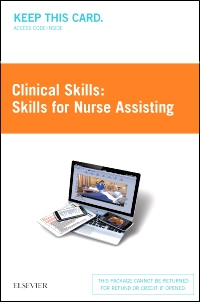
Clinical Skills: Skills for Nurse Assisting (Access Card), 1st Edition
Clinical Skills Online - Access Card

$49.95
Learn to master the most important nursing skills before you ever step foot in the clinical environment. Clinical Skills: Skills for Nurse Assisting Collection is an engaging, web-based learning tool that guides users through 64 of the most important nursing skills for nurse assisting. Each skill in the collection uses the same seven-part framework to walk you through every aspect of the skill. From special patient and safety considerations to the equipment and techniques used in the skill, this assembly of high-definition videos, interactive learning tools, and in-depth explanations will leave you with a 360-degree understanding of how to safely and effectively perform each skill.
-
- Continually updated, evidence-based content is reviewed and revised annually by clinical skills experts to reflect changes in practice as they arise.
- Convenient web-based program utilizes the same professional format that practicing nurses use to train.
- Consistent, competency-based format for learning skills offers a standardized way for you to learn and perform skills. Most skills feature the same types of skill learning tools to help you obtain a more holistic understanding of the skill and standard QSEN nursing competencies.
- Quick sheet provides a concise, step-by-step summary of the skill.
- Extended text offers an in-depth look at all aspects of the skill. Subjects addressed in the extended text section include:
- Safety alerts
- Supplies
- Procedures
- Delegation guidelines
- Monitoring and care
- Reporting and Recording guidelines
- Special gerontologic, pediatric, and home care considerations
- Evidence-based references
- Additional reading suggestions
- Interactive visual supply list features roll-over labeling to familiarize you with each piece of equipment needed to perform the skill.
- Demonstration videos visually guide you through every necessary step involved in the skill.
- Images and illustrations highlight crucial procedures, equipment, and documents involved in the skill.
- Competency tests with rationales help you review and evaluate your understanding of the skill.
- Printable evaluation checklists help you measure and track various skill competencies.
-
64 Nurse Assisting Skills Performing Hand Hygiene Using Personal Protective Equipment Using Restraint Alternatives Applying Restraints Safely Moving the Person Up in Bed Positioning the Person in Bed Transferring the Person to a Chair or Wheelchair Moving the Person to a Stretcher Transferring the Person Using a Mechanical Lift Assisting with Range-of-Motion Exercises Helping the Person Walk Giving a Complete or Partial Bed Bath Assisting with a Tub Bath or Shower Giving Female Perineal Care Giving Male Perineal Care Making a Closed Bed Making an Occupied Bed Making a Surgical Bed Performing Oral Hygiene Providing Denture Care Brushing and Combing the Person’s Hair Shampooing the Person’s Hair Shaving the Person’s Face Giving Nail and Foot Care Assisting with Undressing and Dressing Changing the Gown of the Person with an IV Helping the Person to the Commode Applying Incontinence Products Giving the Urinal Giving the Bedpan Applying a Condom Catheter Giving Catheter Care Emptying a Urinary Drainage Bag Changing a Leg Bag to a Drainage Bag Giving an Enema Changing an Ostomy Bag Serving Meal Trays Feeding the Person Measuring Intake and Output Measuring Weight and Height Taking a Radial Pulse Taking an Apical Pulse Counting Respirations Taking a Temperature with an Electronic Thermometer Measuring Blood Pressure Using a Pulse Oximeter Collecting a Midstream Specimen Collecting a 24-Hour Urine Specimen Collecting and Testing a Stool Specimen Collecting a Sputum Specimen Measuring Blood Glucose The Surgical Skin Prep: Shaving the Skin Assisting with Deep Breathing and Coughing Exercises Applying Elastic Stockings Giving a Back Massage Assisting with Pressure Ulcer Prevention and Care Applying a Dry, Non-Sterile Dressing Performing a Hot or Cold Soak Performing a Sitz Bath Applying a Hot or Cold Compress Applying a Hot or Cold Pack or an Ice Bag, Collar, or Glove Using an Aquamatic or Aquathermia Pad Caring for the Person with Confusion and Dementia Caring the for Person with Alzheimer’s Disease and Other Dementias